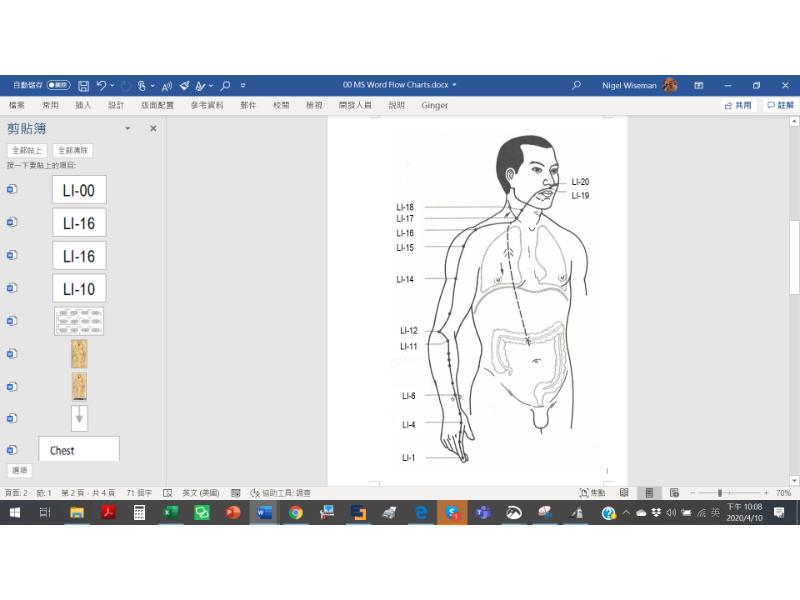Search in dictionary
Hand yáng brightness (yáng míng) large intestine channel
手阳明大肠经 〔手陽明大腸經〕 shǒu yáng míng dà cháng jīng
Abbreviation: LI. One of the twelve channels.
 |
| Hand yáng brightness (yáng míng) large intestine channel |
|---|
Connections
LU → LI → ST; homes to the large intestine; nets the lung.
Large Intestine Channel Pathway
Overview
Radial side of tip of index finger (LI-1) → radial margin of forearm → lateral aspect of upper arm → over shoulder → below C7 → supraclavicular fossa → nets the lung → homes to the large intestine.- External branch:
supraclavicular fossa → neck → cheek → lower gum (LI-20) → ST channel.
Description
The channel hand yáng brightness (yáng míng) large intestine channel begins at the radial side of the tip of the index finger proceeds upward along the radial side of the index finger to LI-4 (hé gǔ, Union Valley) in the fleshy area between the thumb and index finger. It then passes between the first and second metacarpal bones of the hand and between the tendons of the extensor pollicis longus and brevis muscles at the wrist. It continues along the radial margin of the forearm to the radial margin of the lateral aspect of the elbow, then up the lateral aspect of the upper arm and over the shoulder joint to just below the spinous process of the seventh cervical vertebra (C7), intersecting with the governing (dū) vessel at GV-14 (dà zhuī, Great Hammer), where all six yáng regular channels meet. It then travels straight into the supraclavicular fossa.
From the supraclavicular fossa, the channel submerges into the thoracic cavity, nets the lung, and continues downward to home to the large intestine. From the large intestine, it further descends to the lower limb to emerge at ST-37 (shàng jù xū, Upper Great Hollow), which is the lower uniting point of the large intestine.
A branch from supraclavicular fossa ascends the neck and traverses the cheek before entering the lower gum. From here it skirts around the lips, and proceeds to the philtrum, where it intersects with the yáng brightness (yáng míng) large intestine channel from the opposite side of the body, to then continue around the nostril of the opposite side of the body to terminate at the side of the ala nasi (LI-20, yíng xiāng, Welcome Fragrance) to meet the foot yáng brightness (yáng míng) stomach channel. In this way, the right and left channels intersect at the philtrum and run for the last short stretch on the opposite side of the body from which they originated.
Large Intestine Channel Acupoints
Indications of LI Acupoints
The 20 points on the hand yáng brightness (yáng míng) large intestine channel treat disease of the large intestine and disorders anywhere on the pathway. They notably treat conditions of the head and face, ears, eyes, teeth, throat, as well as externally contracted febrile disease.
- Large intestine: Abdominal pain, rumbling intestines; diarrhea or constipation; dysentery.
- Head, face, throat: Toothache, painful swollen throat, runny nose, nosebleed, eye pain, deafness and tinnitus.
- Externally contracted febrile disease.
- External pathway: Heat and swelling or cold pain along the course of the channel.
Major LI Acupoints
| Indications for LI Points |
|---|
|
LI-4 (合谷 hé gǔ, Union Valley): Located on the dorsoradial aspect of the hand, on the radial side of the second metacarpal bone, inferior to the midpoint of the bone (i.e., under the bone).
- Indications: Headache; painful red swollen eyes; nosebleed; toothache; clenched jaw; deviated eyes and mouth; deafness; painful swollen throat; mumps; hypertonicity of the fingers; pain in the arm; febrile disease with absence of sweating or profuse sweating; abdominal pain; constipation; amenorrhea; difficult delivery.
- Stimulus: Needling: 0.5–0.8 cùn perpendicular insertion, i.e., toward the little finger. Moxa: 3 cones; pole 5–15 min.
- Warning: Stimulation of this point is contraindicated during pregnancy.
- Categories: Source point (yuán xué); command point (sì zǒng xué) of the face and mouth; one of Mǎ Dān-Yáng’s twelve heavenly star points; one of the nine needles for returning yáng.
LI-11 (曲池 qū chí, Pool at the Bend): Located on the lateral aspect of the elbow, in the depression at the lateral end of the transverse cubital crease, just distal to the lateral epicondyle of the humerus.
- Indications: Painful swollen throat; toothache; painful red eyes; scrofula; febrile disease; pain in the elbow and arm; paralysis of the upper limbs; abdominal pain; retching and vomiting; high blood pressure; mania and withdrawal.
- Stimulus: Needling: 1. 0–1.5 cùn perpendicular insertion. Moxa: 3–7 cones; pole 10–30 min.
- Categories: Uniting (hé) (earth) point; one of Mǎ Dān-Yáng’s twelve heavenly star points; one of the thirteen ghost points.
LI-15 (肩髃 jiān yú, Shoulder Bone): Located on the lateral aspect of the shoulder, inferior to the acromioclavicular articulation, between the anterior and medial portions of the deltoid muscle, in the most anterior of the depressions that form when the arm is abducted.
- Indications: Hypertonicity, pain, or paralysis of the shoulder and arm; stiff neck and nape; dormant papules; scrofula.
- Stimulus: Needling: 0.6–1.2 cùn downward oblique insertion. Moxa: 7–14 cones; pole 5–10 min.
- Categories: Intersection point (jiāo huì xué) of the large intestine channel and yáng springing (yáng qiāo) vessel.